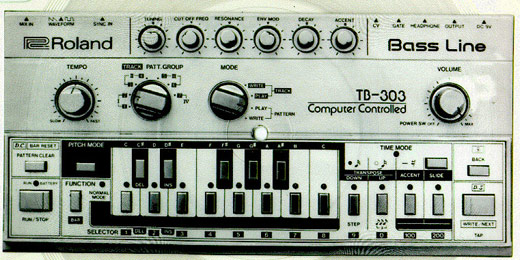It’s difficult to imagine now. Not since Punk exploded a decade before had there been such an outcry, such a controversy in popular music. Like Punk, it was vilified in the press, accused of dragging ordinary teens into drug culture, and the inevitable casualties of the scene were accentuated for shock effect on front pages almost weekly. Banned by the Top of the Pops for its embracing of the drug culture, it was seen (unlike punk) as the second summer of love, as a movement where dancing and losing yourself in the music were essential components. But by the same token, it was an incredibly exciting scene, with revellers playing catch and mouse with the police and local councils (not to mention landowners) to find the best parties or raves.
It seems slight surreal for someone who grew up in the middle of this movement that this track is now 25 years old, certainly it has aged well and still sounds relevent today. Phuture were three Chicago house producers, Herb J, DJ Pierre and Spany who reputedly created the first acid house track. Legend says Sleezy D’s fantastic I’ve lost control was a year earlier in its vinyl release, but Dj Pierre states thst they had actually written Acid Tracks some two years earlier than its release, in 1985, but the latter is thought of as the defining track at the start of Acid house. Its characteristics are repetitive trance like dance music, chanting type lyrics, with the Roland TB-303 synthesiser and its squelchy sound prominent. Although initially popular across Chicago and the scene, police crackdowns on events and parties meant its popularity in the US was fairly short-lived, but it was here that the initial drug culture, and the smiley face image was first noted.
The music translated well over in England though, with Danny Rampling through his Shoom club introducing the genre to London clubbers. Unlike other scenes, people wanted to carry on dancing for hours, but the UK’s strong licensing laws didn’t allow this. People initially started gathering in spaces, empty warehouses and derelict buildings with a soundsystem to carry on partying, and soon the whole scene moved to these areas, and the need for the clubs was gone. British and European artists jumped on Acid House and made it their own, with artists like The Shaman and S’Express taking it into the UK charts.

These parties were the first thing that mobile phones helped with, in their complete infancy. Illegal as they were, they couldn’t be advertised, so messages by phone, and even bits of paper were passed around letting people know where the parties were going to be. Plans would change, parties would get raided, some were a washout, or the soundsystem didn’t work but some, well some were some of the greatest parties there were, attended by thousands with DJs and live acts playing virtually all night.

The drug of choice (and usually there was choice) at the acid house parties was a relatively new drug, Ecstasy or MDMA. When taken (it was usually in tab or pill form) its supposed to induce the user with euphoria and a sense of intimacy. Certainly less anxiety. The down sides were supposedly feeling low, irritability and fatigue. It can, like all drugs, be fatal when taken at such large doses, or as a cocktail of other drugs, and the fatalities were seized up on by a press who had been initially either ambivalent or even vaguely supportive (the Sun sold smiley t-shirts) who were by now hungry to discredit what had become a largely illegal scene. The BBC News included features which scream of this need to erevacably cause the scene to cease.
News Report
1988 Documentary
The symbol for the craze was the smiley. Initially used by Danny Rampling in his flyer promotions for Shoom, Bomb the Bass used it on the cover of their 1988 single Beat Dis. It spread like wildfire into popular culture as an artistic reference to the whole acid house movement, but as the public and press tide turned against the scene, so it faded in popularity.

The Acid House explosion lasted into the nineties. Reliance on the 303 went and the music changed and evolved. The parties became more and more criminalised, with gangs moving in on the early promoters who were just in it to provide a party for people. Guns, drug dealers, even bank robbers moved in 0n the scene, after all it was much easier to rob the promoter of an illegal party of money he shouldn’t really have anyway. The police got more and more wise to where things were happening, and legislation changed to allow clubs to open later.

All this eventually meant by even the early 90’s, the scene was dead. But 25 (or so) years later, not forgotten.
Check out this playlist.














No Comment